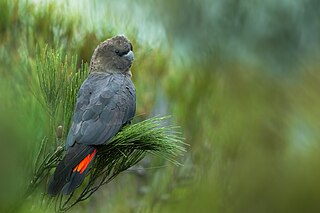
The glossy black cockatoo, is the smallest member of the subfamily Calyptorhynchinae found in eastern Australia. Adult glossy black cockatoos may reach 50 cm (19.5 in) in length. They are sexually dimorphic. Males are blackish brown, except for their prominent sub-terminal red tail bands; the females are dark brownish with idiosyncratic yellow marking around the neck and prominent sub-terminal tail band of red with black bars. Three subspecies have been recognised, although this has been recently challenged, with a detailed morphological analysis by Saunders and Pickup 2023 finding there is cline in body dimensions over the latitudinal range of the species, with the birds from the north of the range smaller than the birds in the south. Saunders and Pickup argued that with no differentiation in bill morphology, little difference in genetic makeup, no differences in plumage pattern or colour, and no differences in diet, there is no justification in subdividing the species.

Barychelidae, also known as brushed trapdoor spiders, is a spider family with about 300 species in 39 genera.

Idiosoma is a genus of Australian armoured trapdoor spiders that was first described by Anton Ausserer in 1871. Originally placed with the Ctenizidae, it was moved to the armoured trapdoor spiders in 1985. The name is derived from the Greek ἴδιος, meaning "individual, unique", and σῶμα, meaning "body", referring to the distinctive structure of the abdomen.

Moggridgea is a genus of spiders in the tree dwelling family, Migidae. The genus was first described by Octavius Pickard-Cambridge in 1875, who named the genus after naturalist John Traherne Moggridge.

Oceanic dispersal is a type of biological dispersal that occurs when terrestrial organisms transfer from one land mass to another by way of a sea crossing. Island hopping is the crossing of an ocean by a series of shorter journeys between islands, as opposed to a single journey directly to the destination. Often this occurs via large rafts of floating vegetation such as are sometimes seen floating down major rivers in the tropics and washing out to sea, occasionally with animals trapped on them. Dispersal via such a raft is sometimes referred to as a rafting event. Colonization of land masses by plants can also occur via long-distance oceanic dispersal of floating seeds.

Aptostichus angelinajolieae, the Angelina Jolie trapdoor spider, is a species of Euctenizidae, nocturnal arthropods who seize their prey after leaping out of their burrows and inject it with venom. It was described by the Auburn University professor Jason Bond in 2008, who named it after the American actress Angelina Jolie in recognition of her work on the United Nations High Commission for Refugees. It was one of only seven described species of Aptostichus until 2012, when it was joined by Bono's Joshua Tree trapdoor spider and 32 other species.
Trittame is a genus of brushed trapdoor spiders first described by German arachnologist Ludwig Carl Christian Koch in 1874. It is endemic to Australia.

Zephyrarchaea austini or the Kangaroo Island assassin spider is a species of Australian assassin spiders that is endemic to the north west of Kangaroo Island, South Australia. It was discovered in 2010, and described 2012 by Michael G. Rix and Mark Harvey, and named for Andy Austin.
Arbanitis maculosus is a species of armoured trap-door spider in the family Idiopidae, and is endemic to New South Wales.
Arbanitis montanus is a species of armoured trap-door spider in the family Idiopidae, and is endemic to New South Wales.
Arbanitis melancholicus is a species of armoured trap-door spider in the family Idiopidae, and is endemic to New South Wales.
Stanwellia nebulosa, also known as the nebular trapdoor spider, is a species of mygalomorph spider in the Pycnothelidae family. It is endemic to Australia. It was described in 1918 by Australian arachnologists William Joseph Rainbow and Robert Henry Pulleine.

Arbanitis gracilis, also known as the silver-haired trapdoor spider, is a species of mygalomorph spider in the Idiopidae family. It is endemic to Australia. It was described in 1918 by Australian arachnologists William Joseph Rainbow and Robert Henry Pulleine.
Blakistonia aurea, also known as the Adelaide trapdoor spider or the yellow trapdoor spider, is a species of mygalomorph spider in the Idiopidae family. It is endemic to Australia. It was described in 1902 by British arachnologist Henry Roughton Hogg.
Euoplos inornatus is a species of mygalomorph spider in the Idiopidae family. It is endemic to Australia. It was described in 1918 by Australian arachnologists William Joseph Rainbow and Robert Henry Pulleine.
Euoplos ornatus is a species of mygalomorph spider in the Idiopidae family. It is endemic to Australia. It was described in 1918 by Australian arachnologists William Joseph Rainbow and Robert Henry Pulleine.
Euoplos similaris, also known as the banded golden trapdoor spider, is a species of mygalomorph spider in the Idiopidae family. It is endemic to Australia. It was described in 1918 by Australian arachnologists William Joseph Rainbow and Robert Henry Pulleine.
Euoplos variabilis, also known as the Mount Tamborine trapdoor spider, is a species of mygalomorph spider in the Idiopidae family. It is endemic to Australia. It was described in 1918 by Australian arachnologists William Joseph Rainbow and Robert Henry Pulleine.
Idiosoma rhaphiduca is a species of mygalomorph spider in the Idiopidae family. It is endemic to Australia. It was described in 1918 by Australian arachnologists William Joseph Rainbow and Robert Henry Pulleine.







